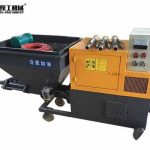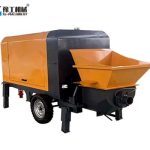GRC (Glass Fiber Reinforced Concrete) is a composite material widely used in construction for its strength, flexibility, and lightweight properties. GRC spray machine is specialized equipment designed to mix and spray GRC material onto molds or surfaces with precision and consistency. These machines are essential for creating GRC panels, architectural elements, and decorative structures. They ensure an even application of the material, which is critical for achieving the desired strength and finish.
Workig Principle of GRC Spray Machine
GRC spray machines operate by combining two key components:
1. Concrete Mix: A blend of cement, sand, water, and additives.
2. Glass Fibers: Thin strands of glass that provide reinforcement and durability.
The machine mixes these components in precise proportions and sprays them through a nozzle at high pressure. This process ensures that the fibers are evenly distributed throughout the concrete, resulting in a strong, lightweight, and crack-resistant material.
Features of a GRC Machine for Sale
1. High-pressure spray system: Ensures consistent application and optimal fiber distribution.
2. Adjustable mixing ratios: Allows customization of the GRC mix for different projects.
3. Portability: Lightweight and easy-to-move machines are ideal for on-site work.
GRC Machines Applications
GRC spray machines are versatile tools used in a wide range of applications, including:
1. Architectural cladding: Creating lightweight, durable facades for buildings.
2. Decorative elements: Producing intricate designs for interiors and exteriors.
3. Infrastructure projects: Building bridges, tunnels, and other structures requiring high strength.
4. Restoration work: Repairing and reinforcing existing concrete structures.
5. Custom projects: Crafting unique sculptures, furniture, and art pieces.
Benefits of Using a GRC Spray Machine
1. Superior strength: The even distribution of glass fibers enhances the material’s tensile strength.
2. Lightweight: GRC is significantly lighter than traditional concrete, reducing structural load.
3. Flexibility: Ideal for creating complex shapes and designs.
4. Durability: Resistant to cracks, weathering, and corrosion.
5. Cost-Effective: Reduces material waste and labor costs.



